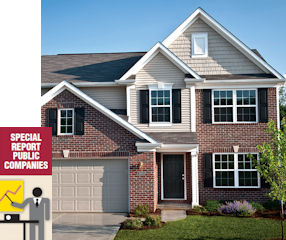The housing market is back. And look no further than Westlake Village home builder Ryland Group Inc. for proof. The firm, which constructs master-planned communities, reported its first full-year of profit last year since 2007, earning $42 million after losing $30 million in 2011. Orders are up, sales are up and the firm has begun to shed excess inventory it was forced to sit on when banks stopped lending to homeowners. Now, shares in Ryland are up too, nearing $40 most days, giving it a market capitalization of $1.76 billion. In early 2009, shares were routinely closing around $13. But is the company ready to take on the next housing crisis, or is it just riding the high until the next bust? Executives at the company recently told investors the downturn taught the firm some valuable lessons and that this time, the company is ready to stay strong no matter what the market does. “(Something) we learned through the downtown is the market has changed from a buyer perspective,” said Chief Executive Larry Nicholson in a Jan. 30 conference call with investors discussing the company’s 2012 earnings. “So that means your product has to change, your marketing has to change and I think that just means we have to be more nimble and just can’t do one size fits all. And I think that’s really the difference in where we see we have a better opportunity going forward.” Ryland has decentralized many of its operations, placing control over land acquisition, construction partners and supply chains in the hands of local management. Last year, the firm acquired already-developed communities and operations in Arizona with the acquisition of Trend Homes in Phoenix. It retained the local management, something that the company says will help them better manage in the local markets. Ryland had exited the Phoenix market in 2009, and saw the acquisition as a way of moving back into the area. Analysts following the company say this could be a valuable model for the firm – even as the company notes that it will likely look less to acquisitions as it moves out of the recession. “That kind of bucks the trend of other competitors,” said David Goldberg, an analyst with UBS Securities LLC’s New York office. “I think they’re probably looking at acquisitions opportunistically, if it works for them to re-enter a market or acquire land in a particular area they want to be in.” Ryland did not return requests for comment. Bouncing back Managing local isn’t the only restructuring Ryland has done in recent years. New land acquisition and community developments have focused increasingly on areas that have rebounded faster, including Arizona and North Carolina, where home prices have bounced back strongly. According to the National Association of Realtors, a Chicago trade group, Phoenix led the country in home price gains for the fourth quarter over the prior year, at nearly 35 percent. But now, with the rebound, the company is planning to return more focus to California and Washington – areas where the cost is higher to build, but also where home prices are higher. A home in Ryland’s Verona Vineyards Phoenix community is listed at $500,000, but a similar home in San Diego’s Fairbrook Estates is asking $936,990. As Ryland’s secondary business is in making mortgages for the buyers of its homes, areas with higher price tags only add to the bottom line, no matter the profit margin on the build. In 2012, its financial services business accounted for $37 million of its $1.3 billion in revenues. And while the company has credited much of its turnaround this year to cost-saving measures, it isn’t determined to keep the operation as lean as it has been. “Certainly in Southern California,” said Chief Financial Officer Gordon Milne, “we’re going into coastal markets that we wouldn’t have touched years ago. So I think you’ll see us having a broader footprint certainly here.” During the downturn, Ryland built smaller communities, but executives have said they expect the numbers in upcoming developments to increase as absorption rates increase. The company currently has operations in 16 markets in 13 states and the District of Columbia, and has indicated it is planning on heavy land acquisition as the housing market begins to improve nationally. Rivals including KB Home of Los Angeles, Lennar Corp. of Miami and PulteGroup Inc. of Bloomfield Hills, Mich. also are ready to play. And analysts say the next big challenge for the firms will be finding land in the right areas – and selling the homes fast enough. “We’ll have to wait and see,” said Goldberg, the analyst. “They’re buying land in the best areas. The rebound has been more concentrated in certain areas with move-up home markets, and that’s where they’re going to buy. If the market moves to first-time homes, they’ll probably move to that.” He notes that Ryland, along with its competitors, are looking for areas where they can shorten the time the land belongs to the developer, and that the strategy of building homes on land with an option to buy the land later has gained traction among many. Some analysts have voiced concern that the homebuilding sector is heading back to full-tilt too fast, but Nicholson said Ryland has seen these cycles before and is ready for it. “I think what we’ve learned through the downturn is we’ve revised our structure, we’re in the right geographic markets,” he said. “We don’t see that growth as a big problem. We’ve done it before.”
